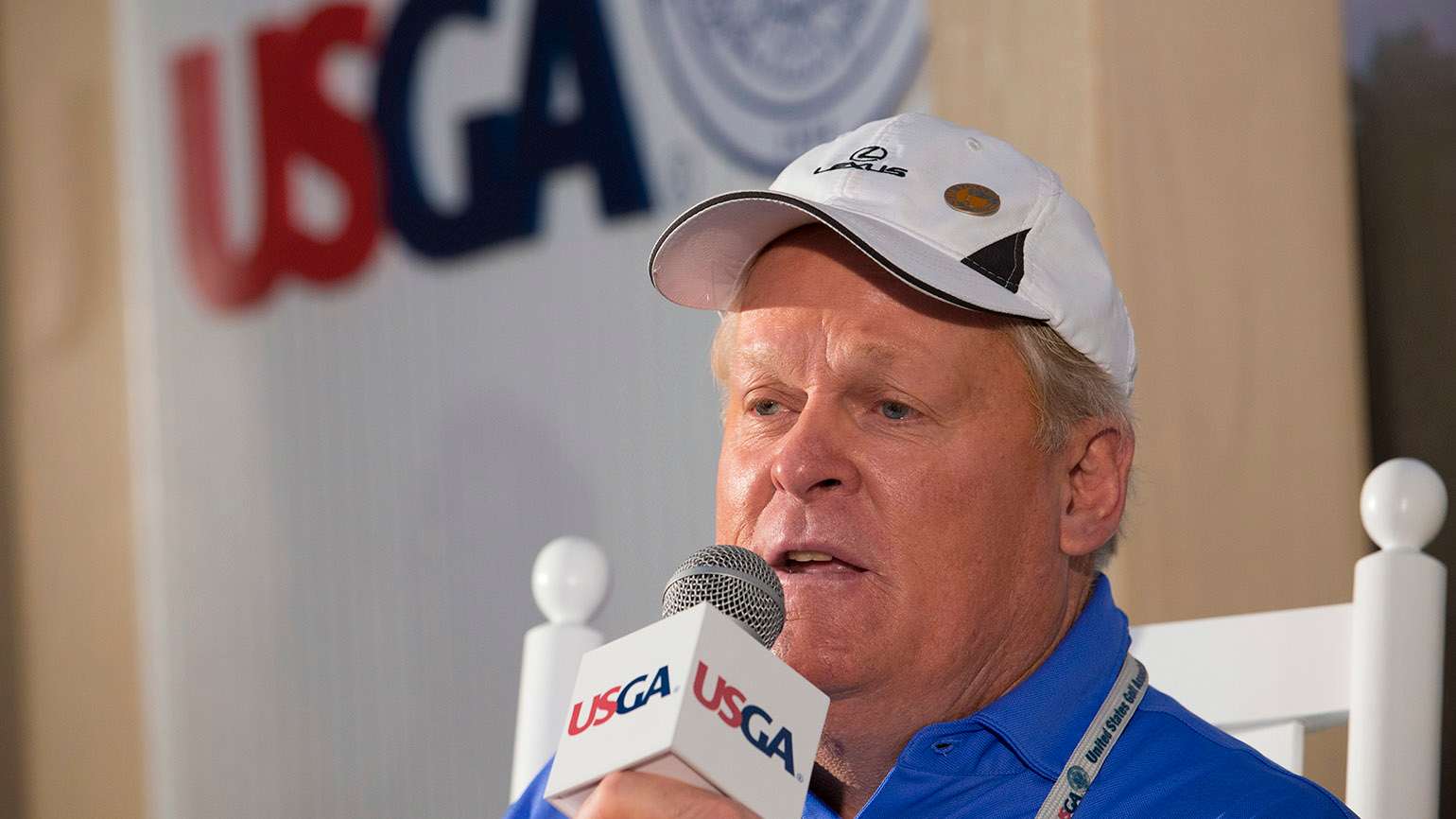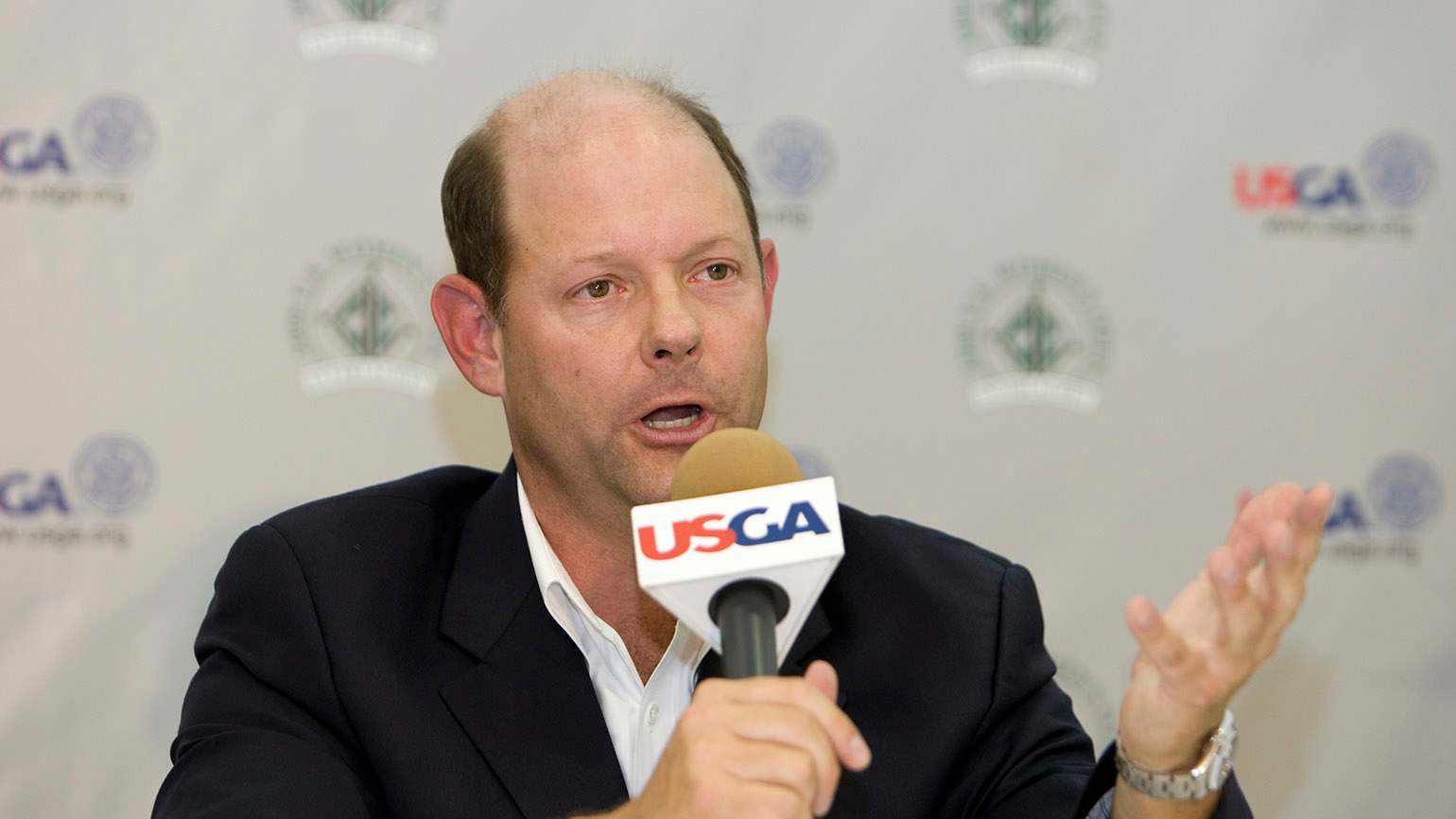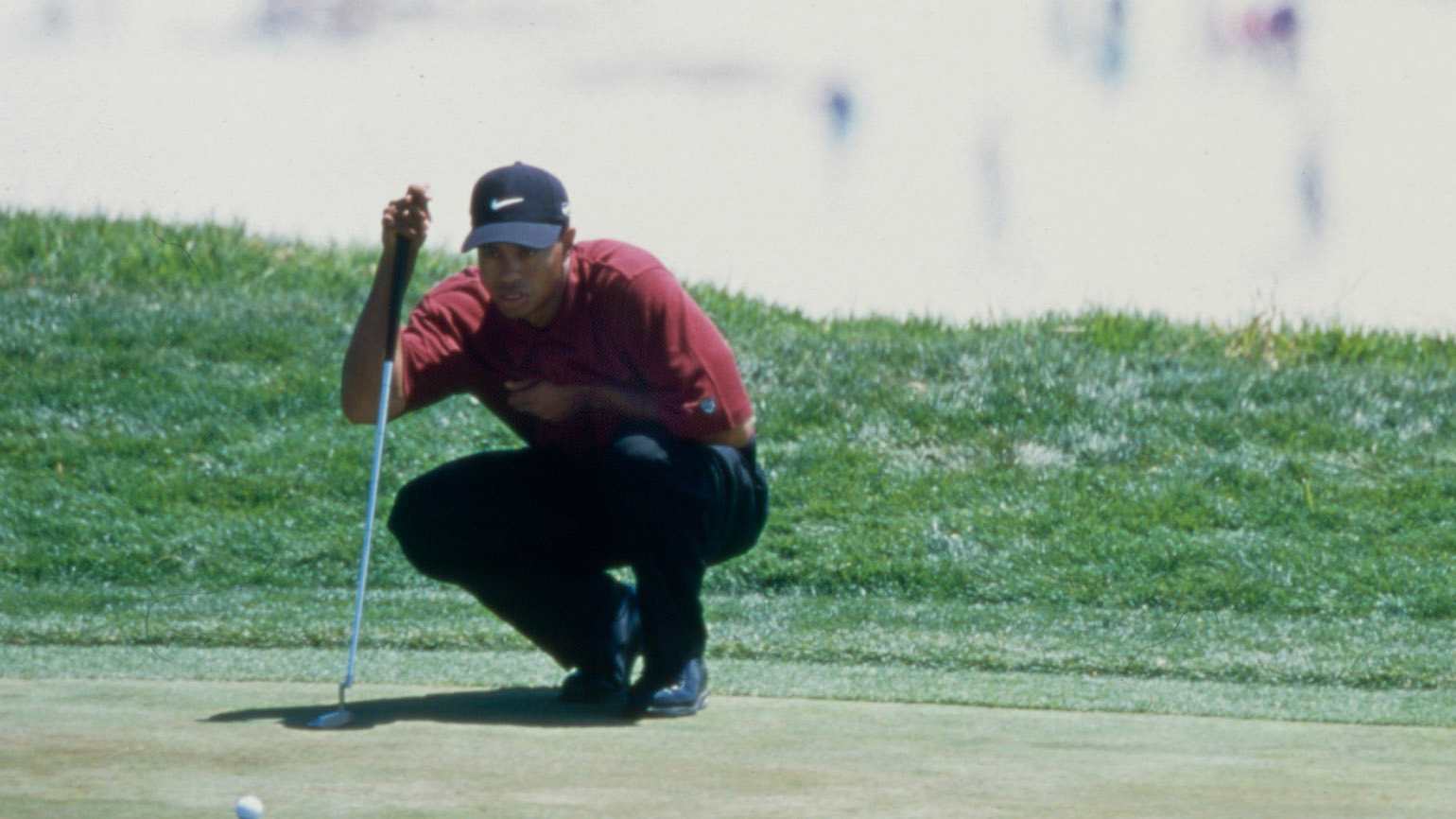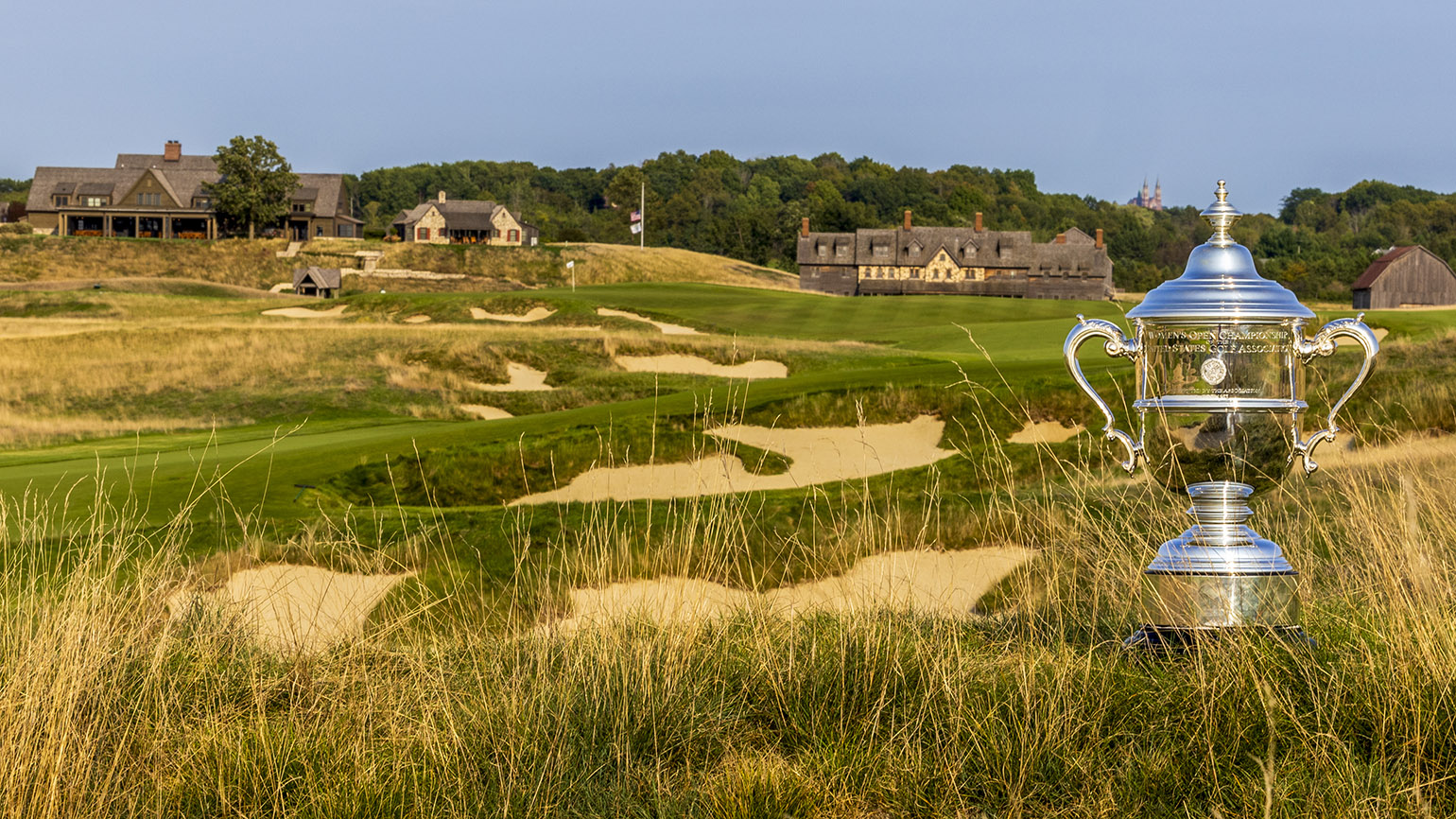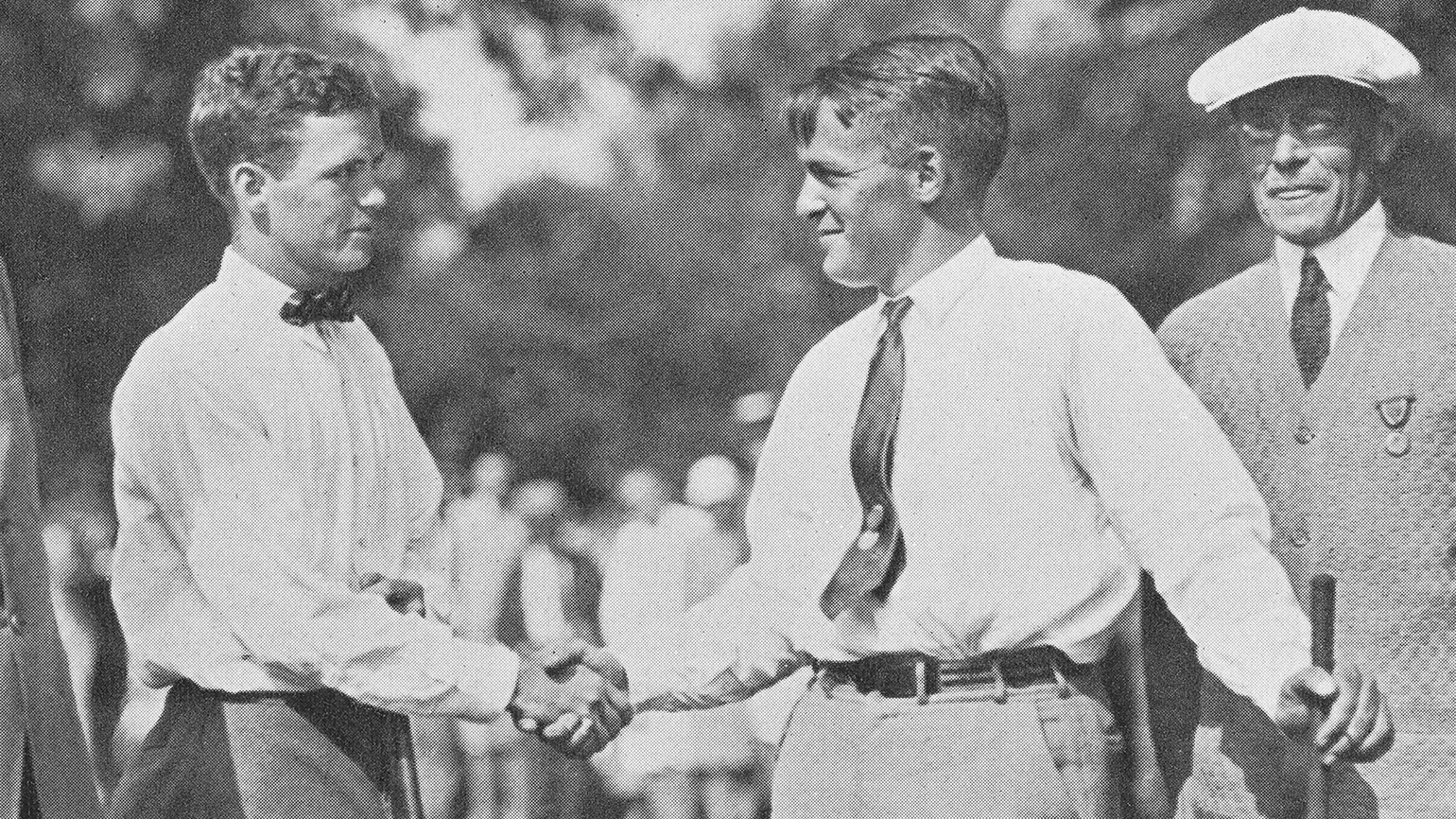Remembering Tiger Woods' Historic 2000 U.S. Open Triumph
Johnny Miller knew something the rest of us did not. Coming off an up-and-down-from-jail birdie on the par-5 14th hole during Round 1 of the 2000 U.S. Open, Tiger Woods walked to the par-4 15th at Pebble Beach Golf Links. That’s when Miller, NBC’s lead golf analyst, uttered a sentence that even his broadcast partner, Dan Hicks, could not believe.
“I think it’s going to be very tight with the rest of the field, but I really do believe, I’ve got this hunch, that Tiger’s going to break every U.S. Open record this week and maybe win by a big margin,” Miller told the audience watching on NBC. “ … I just had the feeling that if he could get off to a great start, which he has done, it could be a week that he just says, ‘See ya, guys.’”
Really? Just 14 holes into the 100th U.S. Open? On Thursday, when a benign Pebble Beach was yielding red numbers? When Woods only had a share of the lead?
Hicks paused.
“Right when he said it, I looked over at him and as if to say ‘Are you crazy, going there right now? We’re in the first round,” NBC’s play-by-play man said. “This is a little early.’”
By the time the week was done, Woods had lapped the field. Not by two or three shots. Not by six or seven. Not even by a dozen. Tiger Woods won by a record 15 shots, and was the only player in the field to better par over 72 holes.
“It’s the greatest golf I’ve ever witnessed, and I believe the greatest golf that has ever been played,” six-time major champion Phil Mickelson said years later.
Woods finished at 12-under-par 272; the next closest among the 63 players to survive the 36-hole cut were two-time champion Ernie Els and Miguel Angel Jimenez … at 3 over.
“In 2000 … I was good,” Woods said recently, the knowing smile telling its own story.
What follows is a look back at that historic week from those who were there or among the millions worldwide who watched at home. The recollections are taken from comments made during that week, the years that followed and new interviews conducted as the 25th anniversary of Woods’ historic win arrives this June.
That time 🐅 tamed Pebble Beach in the 2000 #USOpen ... 😱 pic.twitter.com/0c1YGS0geQ
— U.S. Open (@usopengolf) February 10, 2019
The Practice Rounds
The 2000 U.S. Open was far from ordinary. It was the 100th playing. There was a pall because Payne Stewart, who had perished seven months earlier in a plane crash, was not there to defend his title won the previous June on a misty Sunday at Pinehurst. Also, another of the game’s icons, four-time champion Jack Nicklaus, was competing in his 44th and final U.S. Open. Given a special exemption by the USGA, Nicklaus had always said Pebble Beach, where he won the U.S. Amateur in 1961 and U.S. Open 11 years later, was his favorite course.
Gary Koch (NBC announcer)
Payne not being there was strange, especially for the reason that he was not there. I remember the salute, with all the guys hitting balls out into Carmel Bay, which was very moving. Those of us that knew Payne, it was an emotional day.
Jack Nicklaus
In my mind, I've always said that if I had one round of golf to play, I'd like to go to Pebble Beach. I love Pebble Beach. … Will I enjoy this week? Yes, because it's Pebble Beach. And if I was going to pick a spot to want to play my last Open on, I would probably pick Pebble Beach.
Sure, Tiger Woods arrived at Pebble Beach as the favorite. But remember, in June of 2000, he wasn’t yet that Tiger Woods. He’d won the 1997 Masters, and the 1999 PGA Championship. That’s it – so far. He hadn’t yet won the U.S. Open, despite having claimed an unprecedented six USGA titles in six years, starting with the 1991 U.S. Junior Amateur and culminating with his third consecutive U.S. Amateur in 1996. But now, in the 100th edition of our National Open, at iconic Pebble Beach, that was about to change.
Vijay Singh
If you look back and see who's won all the U.S. Opens lately, obviously, you've got to have Tiger up there in front of everybody else. But David [Duval] played well last week. And I played with Nick Price and he's hitting the ball good. And [Greg] Norman is hitting the ball good. Nobody really focuses on those guys, but their game suits conditions like this.
David Duval
I think any time Tiger plays a golf tournament, you have to look at him as a favorite. But I think this is the kind of event that brings everybody closer together, and it becomes a real patience contest. You've really got to be careful of what you're doing.
Colin Montgomerie
Well, I don't have long enough to talk about the impact that Tiger Woods has made on golf right now. I don't have the time; we'd be here for a while, OK? Tiger Woods' presence at any tournament, whether a major or not, makes it a bigger and better tournament. And we're all anxious as players and as media, I'm sure, and the public would agree that we're all looking for one score all the time -- and it's his.
Tom Watson
You can't put him in any historical perspective, because it hasn't been done yet. But obviously, he has the talent right now to dominate the game for a long time. Even though we have a lot of great players out there, he's the standard. He's the person on the leader board that everyone looks for. You look for him, the players look for him, the golf fans look for him, and the non-golfing fans look for him. He's the man.
Tiger Woods
If you go around and make 72 straight pars, I guarantee you have a chance to win.
Steve Williams (Woods’ caddie at the time)
When your player is in good form and he’s excited and he’s ready for the situation, you just can’t wait for the first round to get going.
First round
The conditions were benign. The sun was shining. The wind was light. Pebble Beach was giving up birdies. A lot of them. Jimenez shot 5-under 66. John Huston posted 67. Local hero Bobby Clampett, who spent most of his time in 2000 as an announcer and qualified for the championship, fired a 68. Woods made it all look so easy, so effortless. After the birdie at 14, he grabbed a share for the lead. That’s when Miller spoke up.
Roger Maltbie (NBC announcer)
I was in the tower. My mic and headset were always open to Johnny. So, I was never shocked when he made bold claims. So, I can’t say I was surprised. But I guess my reaction was,That’s kind of sticking your neck out there. Johnny had a great sense for all of that. He really did. He didn’t miscall too many of those things. You kind of wondered what little crystal ball he had that allowed him to see and feel all of those things.
In fact, it appeared Miller might have had some inside information when he called a blowout 14 holes into a 72-hole major championship.
Mark O’Meara
We were on the 16th tee [during a practice round] and all of a sudden I felt this tug on my shirt. And I turned around and it was Johnny Miller. Johnny’s like ‘Mark, how’s the kid hitting it?’ I said ‘Johnny, that kid right there is the greatest player I’ve ever seen. He’s the greatest player in the world.’ He never missed a shot out there in the practice rounds. I said to Johnny, to be fair, if he doesn’t win this week, I’ll be absolutely shocked. I know Johnny said it on the air later on, but I think I gave Johnny a little of that information.
Woods finished with a bogey-free 65, his lowest round ever at the U.S. Open. When the day ended, he had a one-shot lead over Miguel Angel Jimenez.
Woods
Now if I could do it four straight days, then I think it’d be pretty good.
Mark Rolfing (NBC announcer)
It was a picture-perfect round. The only time he came close to a bogey was the par save on 17. Other than that, he played fabulous.
Woods
[On Wednesday], actually since I've been here, my [putting] stroke hasn't been as comfortable as I'd like to have it. I was making putts, yeah, but there are certain ways of making putts. Either they go in properly, or you just kind of scoot them in. I didn't like the way I was rolling the ball. I was making quite a few putts in practice rounds, but the ball wasn't turning over where I'd like to see it roll. And I worked on it for about a couple of hours and found that my posture was a little off, my release wasn't quite right, I wasn't releasing at the right time, and I just needed to get, basically, some reps in. Once I get enough reps, I feel a little more comfortable. And I putted beautifully.
Maltbie
You can’t get too far behind Tiger. That would be a big mistake.
Miller
Fifty years from now, this will be the time of his career people remember. Everything looks easy and he’s just better than everyone else.
Second Round
The fog rolled in. And due to the ensuing delays, Woods would not start his second round until 4:40 p.m. local time. But the timing felt appropriate – and not accidental. As Woods stood on the first tee, waiting to begin, there was applause coming from the 18th. Over there, Nicklaus was playing his final hole, reaching the iconic par 5 along Carmel Bay in two. (He would three-putt for par.)
Woods
It was nice to hear [the ovation for Nicklaus], I wish I could have been there. But I had a little more important things to take care of.
Mike Davis (Then the U.S. Open Championship Director)
When we did the pairings in 2000 …. you do try to spread out the big names. I do recall we put some thought … We knew Tiger was the guy. He was the biggest name in the field. So, there was thought put into it. We knew Nicklaus would finish in the morning on Friday. And Tiger was on the first tee as he was finishing.
Woods was steady early in his second round. He blasted his tee shot at the second 35 yards past fellow competitor Jesper Parnevik. Woods’ first bogey of the championship came at the fifth. But then came the sixth hole and perhaps the most memorable shot of an unforgettable week.
Maltbie
It was one of those moments where it was ‘How in the world did he take on this shot and then pull it off?’ It was remarkable.
Maltbie, a Northern California native, would know. He’s been around golf for half a century. But what he said as Tiger Woods hit his second shot at the uphill, par-5 sixth hole in the second round of the 2000 U.S. Open might be the moment for which he is most remembered.
Maltbie (continued)
We had seen players drive the ball into the right rough on No. 6 a number of times. They go over there, and they shake their heads. The second shot is up over a steep hill. And at the time, there was a tree that grew up out of the side of the cliff, that came up higher than the cliff. And that was in Tiger’s path to the hole. We’ve seen player after player get over there and then just have to hack it out short and then have to hit a very long third shot, blind up over that hill where they can’t see anything other than sky. It was really bad place to put the ball off the tee. The next thing you know, Tiger’s grabbing a club out of the bag, and we can see he’s aiming at the green. And we’re like ‘What’s this all about?’ He takes a hack at it, he’s moved heaven and earth, and half of Pebble Beach seems to be flying in the air. Next thing you know the ball ends up on the edge of the green. My only reaction, I was so dumbfounded by it all, I uttered ‘It’s just not a fair fight.’
"It's just not a fair fight."@TigerWoods was on another level during the 2000 U.S. Open at Pebble Beach. pic.twitter.com/DDpvhglU4z
— U.S. Open (@usopengolf) February 4, 2023
Mark Rolfing
From 202 yards, out of the rough, up the hill, 7-iron. You’re right, Rog, it’s not a fair fight.
Gary Koch
Look at the smile on Tiger’s face. He is the only man in the field who could do it.
Because of the fog and late start, Woods would not finish his second round. In near darkness, he arrived at the long par-3 12th. To that point, 16 percent of the field had hit the green. Woods found the center of the small putting surface and had a 40-footer. The horn blew, suspending play. But Woods had the option of finishing. Instead of waiting till morning to hit the birdie putt on fresh greens, Woods opted to putt – and made it. NBC’s Mike Tirico, for emphasis, turned one word into two. Good. Night.
Woods
On 12, it was just one of those putts where I was trying to get it close. I had good speed and just "Get out of Dodge." And it just went in.
Davis
When I think back, everybody remembers the shots that he hit – especially the one at No. 6 – I get that. But when I actually think back to the 2000 U.S. Open and how dominant Tiger was, I think about his putting. Listen, when you win by 15 shots, you’re doing everything well. But if he had just an average putting week, he would have won by six, seven, eight shots. He still would have been dominant. But I’m telling you, he putted the lights out that week.
At 6:30 a.m. PDT on Saturday, Woods returned to finish out his second round. He was cruising along, his lead only growing. But then, he snap-hooked his tee shot into the ocean at the 18th. Fortunately, NBC was ready to bleep out everything Woods said as his Nike ball rattled around the rocks.
Woods
I got a little angry there. I let the emotions get the better of me. I hit a bad shot. I was trying to hit a nice little straight ball out there and I hit a pull hook. I guess I got a little upset. I’m sorry I did get upset, but I think anyone in that situation would get a little perturbed at themselves. Unfortunately, I let it voice out loud.
What no one knew at the time was Woods was now down to the final ball in his golf bag. He had taken three out the night before to practice putting in his hotel room and never put them back. On Saturday, he scuffed up a ball out of the rough at the 13th and tossed it to a kid along the ropes as he headed to the 14th tee. When the tee ball went left on 18, he was down to one.
Williams
That’s part of my job, to make sure we’ve got all we need for the golf course. I can’t explain to him we don’t have any golf balls left. If I say that to him, he’ll say put the clubs down and walk back home.
Woods (to ESPN)
I hit one halfway to Hawaii. All of a sudden Stevie suggests I hit iron off the tee, and I did not say nice words to him at that time. I knew something was up, but I didn’t say a word.
Davis
Nobody at the time knew anything about this one ball left thing. I found out about it later because I got a fair amount of questions. What would happen? What’s the procedure on that? To hear Steve Williams’ version of that is just classic. You have to play the entire round with the same type of golf ball. It doesn’t mean you can’t borrow a golf ball from somebody. If you’re playing a Titleist Pro VI, and you run out of balls, and your fellow competitor, or even somebody in the crowd has the same type of Pro VI, no problem. But I believe Tiger was the only one in the field playing that kind of Nike golf ball.
In that case, he would have been penalized two strokes had he put another ball into play. If he said ‘Steve, run up to my hotel room and pick up some more balls,’ he would have gotten nailed for delay of play. He was getting nailed either way.
It would not have been a disqualification. He could have played a Titleist on the last hole and gotten a two-shot penalty, but it wouldn’t have been a DQ.
The world would not know until years later, because Woods ripped his second tee shot down the right side of the fairway. Despite making a closing bogey, Woods posted 2-under 69 and was up six shots, the largest 36-hole lead in U.S. Open history.
Mike Tirico
Nobody in their individual sport is anywhere close to where Tiger is at the top of this game.
Bobby Clampett
I just sit back and stand in awe of the kid. Any time you think he can't do something, he proves you wrong.
Maltbie
In Jack’s day, Jack was clearly better than what was next. But the margin was much smaller than Tiger as opposed to the rest of the field. He was way better. And everybody knew it. Including all the other players.
Woods then waited … and waited … and waited for his third round to start. Seven hours after the drama at the 18th to close Round 2, he started his third. On No. 2, Woods rolled in a 30-footer for birdie. He raised his putter. He pointed at the hole. He pumped his first. Trademark Tiger as the lead swelled to eight shots. Then he made an absolute mess of the third hole. He needed three chips to get the ball on the green after his second shot buried itself in the rough next to the short-right bunker. By the time he was done hacking away, he carded a triple-bogey 7.
Woods
I did not hit that bad a shot on 3, and to get – I don't know how my ball ended up where it did. If you look at that lie, you can barely see the golf ball. I was playing sideways, and I couldn't even play sideways. And I thought about taking it out and taking an unplayable, it was that bad. But I figured: Go ahead and play it, you might be able to get it to the fairway or get in the rough where you can pitch on and get a putt. I couldn't get it out.
Davis
I was there when he made the triple on No. 3 in Saturday’s third round. What I remember is that he used to get fairly upset, then he’d let it go. After he finished the hole and made 7, he gave this smile. And I’m thinking, ‘I don’t know how to take that.’
Woods
But I smiled just because of the fact I didn't hit that bad a shot, and I ended up walking away with 7.
Butch Harmon (Woods’ swing coach at the time, to Sky Sports)
It didn’t even faze him. The beauty of the entire week was that he was in total control of everything he did. His swing, his putting, his mind, everything was just perfect.
With the wind starting to howl, Pebble Beach had really started to show its teeth.
Woods
I think it played into my hands because it became hard to make a run. If I played solid, hit a lot of fairways, hit a lot of greens and made pars I’d pick up shots because the wind was blowing so hard.
Ernie Els
The wind is such a factor on this golf course.
Davis
In that third round, that was the type of wind you wanted to see for one round. It wasn’t overwhelming. It didn’t make the course play unfairly. It just made shot-making – controlling trajectory, where to land the ball [more challenging]. When it gets windy and those greens get firm, they play like postage stamps. This is where Jack Nicklaus, Ben Hogan, Tiger Woods, the reason they we so ridiculously good in U.S. Opens, I’m convinced they just thought better than other people. When it was really windy and really dense, he was just hitting these low bullets and controlling his ball beautifully. When somebody plays that kind of golf, and manage it under those kind of conditions, it’s fun.
Woods would expertly navigate the wind. And even with that triple-bogey 7 on the card, he managed to get around Pebble Beach in even-par 71, good for a 10-shot cushion. In comparison, Thomas Bjorn, who played alongside Woods in the third round, shot 82.
Woods
To expand it to the point where it's at right now, no, I didn't think it would. But I knew if I shot even par or somewhere close to that, I'd probably pick up a shot or two, just because the conditions were so severe out there, that anything – just grind it out, shoot your level par, and post it. And I just figured that with that much wind and that much rough out there, that the guys might have a little trouble.
Johnny Miller
The bottom line is great champions win here. You look at it – Nicklaus wins here, Watson wins here, Kite wins here. They are all all-time leading money winners when it happened. Now you have Woods, who is apparently going to win here, and win in record fashion.
Craig Smith (Then-USGA Director of Media Relations, who was walking with Woods’ group in the third round)
After Round 3, Tiger was more interested in the Lakers’ playoff score. He was so dominant it was just so matter of fact.
Fourth Round
Even with Woods holding a double-digit lead, interest didn’t fade. A blowout? So what. People wanted to see just how big the final margin would be.
Mike Davis
I think people knew they were witnessing history. There is that Tiger factor. He just attracts eyeballs.
Craig Smith
There’s only one person who was going to bring that kind of excitement with that big of a lead. My aunt never watched golf. When Tiger played, she watched. Even when she had dementia, she watched Tiger play golf.
If you thought Woods, with that big a lead, was going to put things in cruise control, you just weren’t paying attention. He opened with nine consecutive pars. Then he walked in a birdie at the 10th. He rolled in a 20-footer for birdie on 12 and nearly jarred his approach at the 13th. Enough? Nope. He birdied the par-5 14th, too.
Ernie Els (to Golf Channel)
It was like a victory walk for him. It was an amazing walk. It was tough for me because I was like a sideshow and people knew they were watching history being made. It was really the coming out party of Tiger really showing how he’s going to dominate the game in that era. Thinking back, the golf I watched that day was still some of the best I’ve ever seen. A special day.
Davis
I know people don’t believe this because they think we want even par to win. We’re not that good. We literally do not have that kind of control. What you want it to be is golf’s toughest test. After that U.S. Open, I got letters and calls from people saying ‘That was an embarrassment. You should never go back to Pebble Beach again.’ I just remember saying to myself, ‘Are you kidding me? This was one guy. He won by 15 shots.’ The next two best players, out of 155 players [in the field], were plus-3. Why can’t you just celebrate it?
Miller
All in all, this is an Open to remember.
Still, there would be one more lasting image. After airmailing his approach shot into the 16th green, Woods raced his chip 15 feet past the hole. As he rolled in the par putt, he glanced to his right and glared. He was headed toward the biggest win in major championship history. In that moment, his focus was singular: He didn’t want to make a bogey.
Davis
One of the things that makes him different is that, had any of the other 155 players that week had that big a lead, where you have a 10-shot lead going into that last round, I’m telling you, every other player would have played conservative, said to themselves you’ve got this thing locked up unless you make a mistake. That’s how everybody else thinks. He was thinking I want to play a bogey-free round. Who would think that way?
Els (to Golf Channel)
Tiger, back in those days, he was very intense. He was really playing every shot 100 percent to his ability. He was not backing off one inch. I remember he made a putt on 16 for par and he was fist-pumping, and I was like, The tournament is over. But obviously he didn’t want to make a bogey.
Roger Maltbie
It was like ‘What the heck is that all about?’ As long as he doesn’t die in the next two holes, it’s over. This is something that cannot be quantified and I can’t explain it, but you can you look at guys like Tiger, the superstars, and you can tell when they have that look in their eye. Tiger definitely had that look in his eye.
In the end, his final-round card was perfect. A 4-under 67 for his second bogey-free round of the week. In all, he led the field in driving distance, averaging 299.3 yards, and greens in regulation, hitting 70.8 percent of greens in regulation in a week when the field average was 48.7 percent. His 51 greens hit were seven more than any other player registered in driving distance and greens in regulation. He had the best scoring average on the par 3s, par 4s and par 5s.
Dan Hicks
Every once in a while I say to myself in this major championship, Is this really happening. It’s that amazing. You try to think back to a single dominant performance in the past … you look back to Wayne Gretzky in hockey or Michael Jordan in basketball, those are team sports. To emphasize this more, he isn’t just winning these championships, he’s just destroying the rest of the people in the field. This wasn’t an Open, this was closed the second Tiger teed off. A remarkable week by a remarkable player on a remarkable golf course.
Gary Koch
I think that was the start of other players realizing that he played the game at a level that probably no one else had played. To win a major championship by 15 shots, and the way he did it … he made it look easy.
Miller
You have to look at this and say this is the greatest performance in golf history. You might be able to take it a step further and this might be the greatest in sports history – period. It’s one of those performances you’ll tell your kids about. You have to put it as the standard for all to follow.
Maltbie
The greatest performance in a U.S. Open. That’s what comes to mind. It’s pretty simple. He made it look simple.
Rory McIlroy (to Sky Sports)
It’s just so dominant. He did everything he needed to do. Golf can feel pretty easy when it’s like that. I’ve, maybe not to that same level, I’ve played tournaments and played well where the back nine has been comfortable and you’ve been able to sort of let it sink in. But to win by 15, it’s remarkable. I don’t know if we’ll ever see a performance as dominant as that again. (Note: McIlroy shot 268 to win the 2011 U.S. Open at Congressional C.C. by eight strokes)
Davis
I remember in 2000, going out, and this wasn’t one day, this was several times, going out and just walking a few holes to watch him play. I love the game of golf, and I love history. Even though you are working, and you are thinking about certain things, you can’t help but to relish history. There’s been dominant performances, but never quite this much.
Woods
I told Stevie, walking up 18, there comes a point in time when you feel tranquil, when you feel calm, you feel at ease with yourself. And those two weeks, I felt that way. I felt very at ease with myself. And for some reason, things just flowed. And no matter what you do, good or bad, it really doesn't get to you. Even the days when you wake up on the wrong side of the bed, for some reason, it doesn't feel too bad. And to have those weeks just happen to coincide with major championships is even better.
Nick Pietruszkiewicz is a Connecticut-based freelance writer who spent 14 years at ESPN. He is an Assistant Professor of Journalism and the Director of the Sports Communications program at Quinnipiac University.



